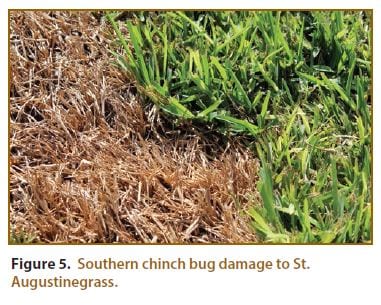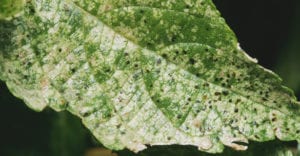Our weather in San Antonio sure does change quickly. A few weeks ago we were inundated with rain; this week the sun is shining bright and dialing up the heat! As promised, here is our second installment in our series on pests and weather. We’re switching gears from the rain and focusing on three of the most common pests we see when the heat arrives in full force.


Photo credit: TAMU Agriflife Extension Service
3 Hot Weather Pests and How to Control Them
1. Chinch Bugs: One of the most irritating pests we have in San Antonio during hot weather are chinch bugs in our turfgrasses. These tiny, hard-to-see pests can quickly destroy patches of your turf in about a week or two during starting mid summer into fall.
Signs of Pests: Grass that appears dried out and does not change when given water. Irregular patches of brown grass in your lawn may have you falling to your knees (literally) in search of these pests. Chinch bugs will always be in the hottest, driest area of your lawn. (Think full sun areas and areas next to driveways, sidewalks or other areas where there is reflected heat.)
Identify Pests: Check for chinch bugs by parting the grass with your hands and looking for tiny black insects with a telltale, irregular white diamond on their back. Check several areas in damaged patch of turf, and be sure to check the areas that look dead and about-to-be dead turf since they are generally more actively feeding there.
Treat Pests: A granular product that contains the active ingredient imidacloprid like, Bonide Insect and Grub, or BioAdvanced Grub Killer Plus. Make sure to read and follow directions on labels. Beneficial Nematodes work wonders on soil-dwelling insects like chinch bugs and grubs too. Beneficial nematodes are only effective while soil temperatures are within the range of 42° – 95°, so treat soon. (By the way, these are the same treatments you can use for grubs in your turf, and June is the month to treat them.)


Spider mite damage has caused these leaves to shrivel and curl, webbing would most likely follow.
2. Spider Mites: Spider mites are some of the smallest, and perhaps some of the most damaging, pests that attack a wide range of plants in our landscapes. They are particularly fond of tomatoes, junipers, marigolds, but will happily go after any neglected plant in your garden.
Signs of Pests: Spider mites suck the juices out of plants turning vibrant green leaves a pale, dull shade. You must not let them get past this stage or their damage will quickly become irreversible. Severe infestations of spider mites result in brown, shriveled, crispy foliage, sometimes encased in a web.
Identify Pests: The “thump” test is the easiest way to identify spider mites. If you suspect a plant has spider mites, hold a piece of white paper under a leaf or twig of the plant and give the plant a good thump. Peer at the paper and you should see really tiny, dark, specks begin to scatter around on the paper.
Treat Pests: Early detection is crucial for control of spider mites. Just knowing that they show up when the weather is very hot and dry will help you be on the look out for them. Systemic insecticides are the most effective on spider mites, WHEN caught early, and WHEN the plant is not an edible. For edibles, you could try spinosad, or neem oil sprays, making sure to spray all over plant and undersides of leaves. NEVER apply neem oil and other insecticides during the hottest parts of the day or you risk burning your plants. Follow label and only apply during cool morning or late evening hours during summer.


Lace bug damage. See how the chlorophyl is being sucked away from the leaf? Picture credit: TAMU Agrilife Extension Service
3. Lace bugs: Lace bugs are elusive pests and hard to spot with your naked eye. They have clear wings for goodness sake! The damage they leave behind though is obvious. Lace bugs (not to be confused with the beneficial lace wings) frequent many different types of shrubs and perennials in our San Antonio landscapes. Lantana, azaleas, lorepetalums, boxwoods, etc…are a few of their favorite meals.
Signs of Pests: Lace bug damage first appears as tiny, tan spots on the leaves of plants. As the infestation grows, so does the damage. Leaves go from green to completely tan, and sometimes you can find sticky, black globs (lace bug poop) on the back of them.
Identify pests: As mentioned before, these pests are hard to see! If you catch a glimpse of one, they are BB sized but their clear wings make it hard to hone in on them. Go by the signs of their damage to help identify.
Treat Pests: Treat lace bugs with a dose of systemic insecticide, or spinosad, pyrethrin, or neem oil. They key is to make sure to coat the plant, especially the undersides of leaves of the affected plant. (Again, no spraying of insecticide during hot hours of the day. Only spray in early morning or late evening hours when it is cool.)
When it comes to any type of insect control in your landscapes, early detection or prevention is of most importance. You can prevent insects from even looking twice at your plants when you give them the best care possible from the start.
Provide plants with a healthy environment by offering them:
- An area free of competing weeds
- A clean living space free of leftover plant and lawn debris
- Proper spacing at planting to allow for proper growth and air circulation
- Proper, consistent watering
- Fertilizer
- Maintenance pruning of broken limbs, and removal of damaged foliage
When you offer you plants the best, you’ll spend more time enjoying them and less time battling pests. Enjoy your summer, but make sure your plants do too!
~The Happy Gardener, Lisa Mulroy

